How to Identify Termites vs. Ants
“Do I have termites or ants?” “They look like ants with wings.” “I saw flying ants.” “Could they be white ants?”
These are common questions and comments we get from customers that think they may have carpenter ants or termites in their house. They do look very similar, but the extermination process for a termite infestation is completely different than it is for carpenter ants. You need to positively identify the insect to make sure you treat the problem properly.
So how do you tell the difference?
Differences Between Ants and Termites
Termites and ants have distinct differences in their body shape, wings, and antennae.
Here, you see a carpenter ant with wings, which are often misidentified as termites.

Body Shape
For starters, the body shape of termites and ants are different. Ants have a very skinny “waist” and “neck,” giving them three distinct body parts. Meanwhile, termites have two different body parts (the head is noticeably separated from the rest of the body).
Also, the termite’s “neck” is not skinny, and their bodies are about the same width as their head.
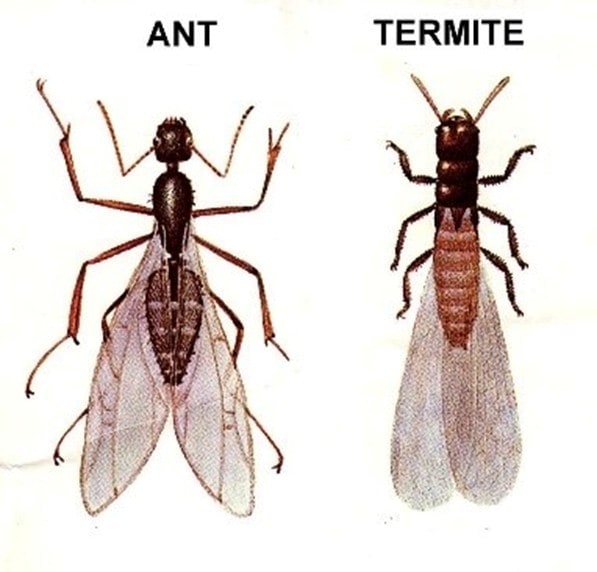
Differences in Antennas and Wings
Termites have straight and beaded antennae, resembling a string of beads. Carpenter ants have elbowed antennae, with a noticeable bend in the middle, giving them a “bent” or “elbowed” appearance. The antennae are segmented and have a more complex structure compared to termites.
During their reproductive stage, termites have wings that are equal in size and shape and are longer than their body. Carpenter ants have two pairs of wings, with the front wings being larger than the hind wings. Unlike termites, the wings of carpenter ants are not as long as their body.
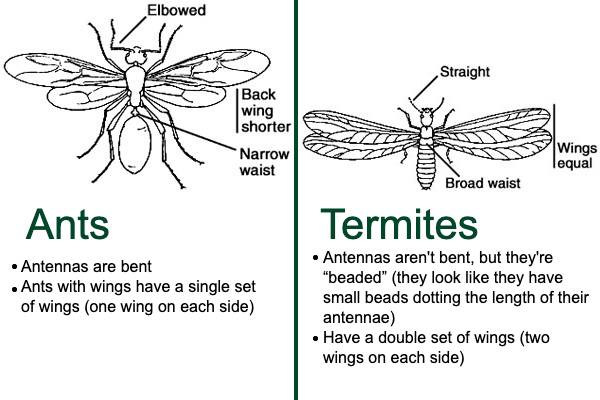
Swarmers
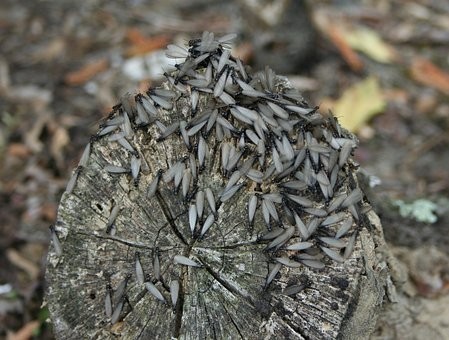
If you come across actual termites, chances are that you’re seeing winged reproductives, which are also known as swarmers. They emerge from the ground, fly around to mate, then attempt to get back into the ground before they die.
Homeowners often find dead swarmer termites near a sunny window. It’s very common for a customer to call us because they see, “a lot of dead ants with wings” in their house.
Termite swarmers are pale in color, another distinguishing characteristic from carpenter ants, which are usually black, red, brown, or yellow.
Worker Termites
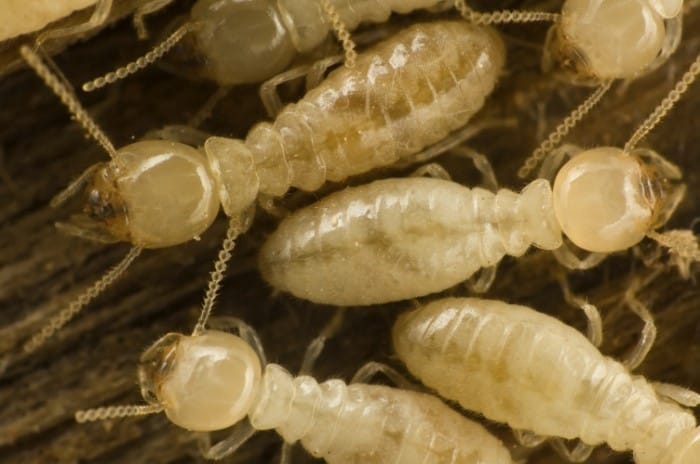
This is the type of termite that eats wood (as well as other cellulose products) and causes damage. The workers work 24 hours a day for their entire 2-year life.
These pests are blind and do not come out into the open. Workers are generally only seen when infested areas (like the inside of walls) are torn apart. When this happens, you won’t see them for long because they’ll scurry away in an attempt to get into a dark, moist area.
The fact is that carpenter ants and termites have multiple life stages as well as multiple member groups, including:
- Queens
- Kings
- Workers
- Soldiers
- Winged reproductives
These groups all have different body sizes, shapes, and colors. Plus, the insects are small, so these differences may be hard to detect.
Signs of Termites
Common signs of a termite infestation include:
- Mud tubes: These tubes are typically brown and about the width of a pencil. They can be found along the foundation of buildings, walls, and other structures.
- Discarded wings: After swarmers find a mate and establish a new colony, they shed their wings. Finding discarded termite wings near windows, doors, or other entry points is a sign of a recent termite swarm.
- Bubbling or Uneven Paint: As termites eat through wooden structures, they can cause paint to bubble or become uneven.
- Sagging Floors and Ceilings: In severe infestations, the structural integrity of wooden floors and ceilings can be compromised, leading to sagging or uneven surfaces.
- Frass (Termite Droppings): Drywood termites push their fecal pellets out of small kick-out holes near their nest. Accumulations of tiny, hexagonal-shaped pellets (often resembling sawdust or coffee grounds) are a sign of drywood termite activity.
A pest control company should be contacted if you think you have a termite problem.
What Type of Termites do we have in Pennsylvania?
Eastern Subterranean Termites are present throughout all of Pennsylvania. The good news is, this is the only species of termites that are native to Pennsylvania. The bad news is that they cause the most damage!
Termites are considered to be a major problem in buildings. They eat wood to feed their colony and build mud tubes.
Signs of Carpenter Ants
Tell-tale signs of a carpenter ant problem include:
- Large black ants
- Sawdust piles
- Small entry and exit holes in wood
- Light rustling noises coming from inside a wall or woodwork
The window sill below, like most others, was supported with wood inside the vinyl covering. Carpenter ants destroyed the wood inside of the vinyl. When we got there, these pests were in the walls.
You can also see the moss growing on the window frame, which is a sign of moisture. These ants prefer moist wood.
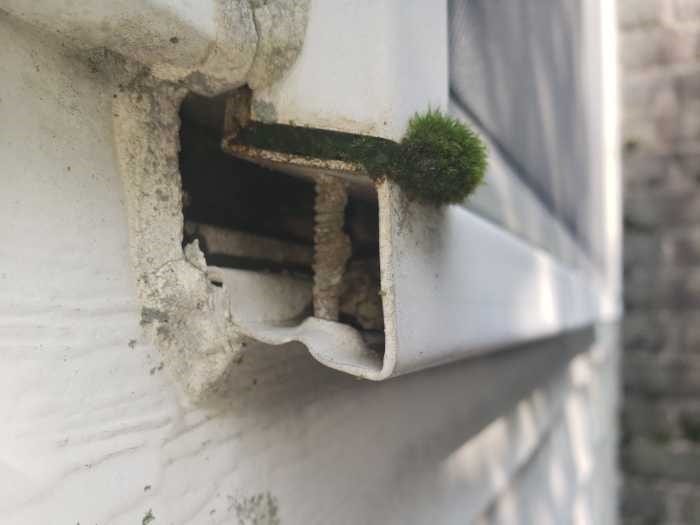
Carpenter ants will also build their nests in wood, chewing their way through the wood to create their own “galleries.” You may see piles of small wood shavings (frass) near their nesting sites.
Carpenter ants are most active at night, whereas termites are just as active during the day and night.
Learn more about Green Giant’s ant control services.
What’s Worse? Termites vs Carpenter Ants
Both insects can cause serious damage to the wood in your house. Typically, termites do more damage, but that’s not always the case. If you have either of them, it’s important to get a pest control company out to your house. Most companies charge a minimal fee for an inspection, even if you want to try DIY methods.
For the most part, we would rather have a carpenter ant infestation than a termites. For one reason, there are more signs of carpenter ant activity. Termites can be a bigger problem because, very often, you just don’t know that damage is occurring for many years.
But termites cannot live in sunlight for more than a few minutes. Therefore, they will not chew through, for example, wood paneling. They will eat away at the backside of the paneling without breaking through into the room. They can also eat the wood studs inside the walls and the floor or ceiling joists while avoiding sunlight (and detection).
If you’re having problems with either of these wood-destroying insects, don’t hesitate to reach out to the team at Green Giant Home & Commercial.
All of our technicians are licensed by the state of Pennsylvania, and we’re proud members of the Pennsylvania Pest Management Association, the National Pest Management Association, the Professional Pest Management Alliance.